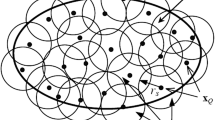Abstract
Transient thermo-mechanical analysis of welding problem requires tremendous computation cost. To accelerate the thermal analysis of large-scale welded structures, an efficient computation scheme based on heat transfer localization and dual meshes was proposed. The computation accuracy is guaranteed by a local fine mesh model with size determined by a theoretical solution and a global coarse mesh model with equivalent heat input. The validity and accuracy of the dual-mesh method were verified using an experimental bead-on-plate model. By extending the weld length, the computation time of the proposed method was proved to be almost linearly dependent on the model scale. The thermal analysis of fillet welding of a large panel structure with 6-m-long weld was accelerated by 10 times over conventional finite element analysis and 2.2 times over adaptive mesh method. Meanwhile, the physical memory consumption was also greatly reduced by the dual-mesh method. Such efficient computation method enables fast evaluation of welding stress and distortion which are vital for manufacturing process and structure performance.
Similar content being viewed by others
References
Lindgren LE (2001) Finite element modeling and simulation of welding. Part 1: increased complexity. J Therm Stresses 24(2):141–192
Nishikawa H, Serizawa H, Murakawa H (2007) Actual application of FEM to analysis of large scale mechanical problems in welding. Sci Technol Weld Join 12(2):147–152
Murakawa H, Ma N, Huang H (2015) Iterative substructure method employing concept of inherent strain for large-scale welding problems. Weld World 59(1):53–63
Ma N (2016) An accelerated explicit method with GPU parallel computing for thermal stress and welding deformation of large structure models. Int J Adv Manuf Technol 87(5–8):2195–2211
Shi Q, Lu A, Zhao H, Wu A (2002) Development and application of the adaptive mesh technique in the three-dimensional numerical simulation of the welding process. J Mater Process Technol 121(2):167–172
Rong Y, Xu J, Huang Y, Zhang G (2018) Review on finite element analysis of welding deformation and residual stress. Sci Technol Weld Join 23(3):198–208
Liu W-K, Zhang Y-F (1983) Improvement of mixed time implicit-explicit algorithms for thermal analysis of structures. Comput Methods Appl Mech Eng 37(2):207–223
Shibahara M, Atluri S-N (2011) The meshless local Petrov-Galerkin method for the analysis of heat conduction due to a moving heat source in welding. Int J Therm Sci 50(6):984–992
Runnemalm H, Hyun S (2000) Three-dimensional welding analysis using an adaptive mesh scheme. Comput Methods Appl Mech Eng 189(2):515–523
Goldak J-A, Mocanita M (1999) Numerical analysis of weldability IIW com. IX, Graz-Seggau Australia
Hamide M, Elisabeth M, Michel B (2008) Adaptive mesh technique for thermal–metallurgical numerical simulation of arc welding processes. Int J Numer Methods Eng 73(5):624–641
Ding J et al (2011) Thermo-mechanical analysis of wire and arc additive layer manufacturing process on large multi-layer parts. Comput Mater Sci 50(12):3315–3322
Radaj D (1992) Heat effects of welding: temperature field, residual stress, distortion. Springer-Verlag, Berlin
Abeles B, Cody G-D, Beers D-S (1960) Apparatus for the measurement of the thermal diffusivity of solids at high temperatures. J Appl Phys 31(9):1585–1592
Huang H, Serizawa H, Wang J, Murakawa H (2013) Development of thermal elastic-plastic FEM for line heating with remeshing technique. Q J Jpn Weld Soc 31(4):134–137
Wang R, Rashed S, Serizawa H (2008) Numerical and experimental investigations on welding deformation. Trans JWRI 37(1):79–90
Wang H, Zhang Y, Chen K (2016) Modeling of temperature distribution in laser welding of lapped martensitic steel M1500 and softening estimation. J Manuf Sci E-T ASME 138(11):111006
Ueda Y, Murakawa H, Ma N (2012) Welding deformation and residual stress prevention. Butterworth-Heinemann, Elsevier, Oxford
Murakawa H, Serizawa H, Tejima M, Taguchi K (2005) Fractal multi-grid method for ultra large scale mechanical and thermal simulations. Trans JWRI 34(1):107–111
Huang H, Murakawa H (2013) Development of dynamic mesh refining method for large scale thermal and mechanical analysis in welding and line heating. Trans JWRI 42(1):63–70
Ma N, Huang H, Murakawa H (2015) Effect of jig constraint position and pitch on welding deformation. J Mater Process Technol 221:154–162
Zhang C, Li S, Sun J, Wang Y, Deng D (2019) Controlling angular distortion in high strength low alloy steel thick-plate T-joints. J Mater Proc Technol 267:257–267
Ooi S-W, Garnham J-E, Ramjaun T-I (2014) Low transformation temperature weld filler for tensile residual stress reduction. In: Mater Design (1980–2015), vol 56, pp 773–781
Barsoum Z, Gustafsson M (2009) Fatigue of high strength steel joints welded with low temperature transformation consumables. Eng Fail Anal 16(7):2186–2194
Gadallah R, Tsutsumi S, Hiraoka K, Murakawa H (2015) Prediction of residual stresses induced by low transformation temperature weld wires and its validation using the contour method. Mar Struct 44:232–253
Acknowledgements
The first author Hui Huang is very grateful to the Japanese Government (Monbukagakusho: MEXT) Scholarship for supporting his doctoral study in Osaka University, Japan. This manuscript has been authored by UT-Battelle, LLC, under contract DE-AC05-00OR22725 with the US Department of Energy (DOE). The US government retains and the publisher, by accepting the article for publication, acknowledges that the US government retains a nonexclusive, paid-up, irrevocable, worldwide license to publish or reproduce the published form of this manuscript, or allow others to do so, for US government purposes. DOE will provide public access to these results of federally sponsored research in accordance with the DOE Public Access Plan (http://energy.gov/downloads/doe-public-access-plan).
Author information
Authors and Affiliations
Corresponding author
Additional information
Publisher’s note
Springer Nature remains neutral with regard to jurisdictional claims in published maps and institutional affiliations.
Rights and permissions
About this article
Cite this article
Huang, H., Ma, N., Murakawa, H. et al. A dual-mesh method for efficient thermal stress analysis of large-scale welded structures. Int J Adv Manuf Technol 103, 769–780 (2019). https://doi.org/10.1007/s00170-019-03606-4
Received:
Accepted:
Published:
Issue Date:
DOI: https://doi.org/10.1007/s00170-019-03606-4




